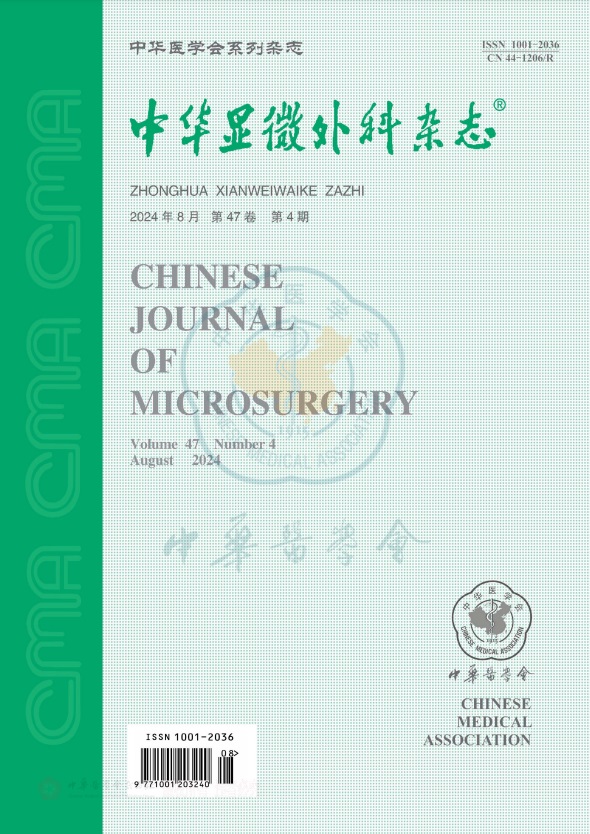丙戊酸体外诱导大鼠脂肪干细胞分化的研究
引用次数: 0
摘要
目的研究丙戊酸(VPA)对大鼠脂肪干细胞(ADSCs)的体外诱导分化作用。方法自2016年11月至2017年10月,从2只健康的3周龄Sprague-Dawley(SD)大鼠身上分离ADSCs,培养至第3代,诱导前用10ng/ml bFGF处理24小时。诱导培养基中加入不同浓度的VPA:B组(0.5mmol/L,200μL)VPA;C组(1.0mmol/L,200μL)VPA;D组(10 mmol/L,200μL)VPA,A组用D-Hank作为空白对照组。每天观察细胞的形态学变化。在诱导7天时,通过实时荧光定量PCR检测神经元特异性烯醇化酶(NSE)、巢蛋白(NES)和S-100的基因表达。免疫荧光染色检测S-100蛋白的表达。采用独立t检验确定差异的显著性。概率低于5%(P<0.05)被认为具有统计学意义。结果诱导后4天,B、C、D组部分ADSCs出现许旺样细胞或神经元样细胞形态,C组变化更明显;A组ADSCs无明显变化,仍呈纺锤形。S-100免疫荧光染色显示,B、C和D组的阳性表达率较高(C组更明显),A和D组阳性表达率较低(A组更显著)。S-100基因表达在C组呈剂量依赖性增加,明显高于A、B、D组(P<0.05),NSE基因表达与S-100呈相同趋势,在C组达到峰值;C组NSE基因表达明显高于A、B、D组(P<0.05)。关键词:脂肪干细胞;施旺细胞;丙戊酸;诱导和分化本文章由计算机程序翻译,如有差异,请以英文原文为准。
The study for induction and differentiation of rat’s adipose-derived stem cells by valproic acid in vitro
Objective
To study the inducting differentiation effects of the vaproic acid (VPA) on rats adipose derived stem cells (ADSCs) in vitro.
Methods
From November, 2016 to October, 2017, the ADSCs were isolated from 2 healthy 3-weeks-old Sprague-Dawley (SD) rats and cultured to passage 3, which were treated with 10 ng/ml bFGF for 24 hours before induction. Then the induction media contained the VPA with different concentrations: group B (0.5 mmol/L, 200 μl) VPA; group C (1.0 mmol/L, 200 μl) VPA; group D (10 mmol/L, 200 μl) VPA, and D-Hank was used in group A as blank control group. The morphological changes of the cells were observed every day. At 7 days of induction, the gene expressions of neuron-specific enolase (NSE), nestin (NES), and S-100 were detected by real-time fluorescent quantitative PCR. The S-100 protein expression was tested by immunofluorescence staining. Significance of difference was determined using independent t test. Probabilities lower than 5% (P < 0.05) were considered statistically significant.
Results
At 4 days after induction, some ADSCs of groups B, C, and D showed the morphology of Schwann-like cells or neuron-like cells, the change of group C was more obvious; and the ADSCs of group A had no obvious change, which still present spindle. The S-100 immunofluorescence staining showed higher ratio of positive expression in groups B, C, and D (more obvious in group C) and lower ratio of positive expression in groups A and D (more obvious in group A). The gene expression of S-100 showed dose-dependent increases in groups C, which was significantly higher than that of groups A, B, and D (P 0.05). The gene expression of NSE showed the same tendency as S-100, which reached the peak in group C; the gene expression of NSE in group C was significantly higher than that of groups A, B, and D (P 0.05).
Conclusion
ADSCs can be induced to differentiate into Schwann-like cells or neuron-like cells under the treatment of VPA, and 1.0 mmol/L is the optimal concentration.
Key words:
Adipose-derived stem cells; Schwann cells; Valproic acid; Induction and differentiation
求助全文
通过发布文献求助,成功后即可免费获取论文全文。
去求助
来源期刊
CiteScore
0.50
自引率
0.00%
发文量
6448
期刊介绍:
Chinese Journal of Microsurgery was established in 1978, the predecessor of which is Microsurgery. Chinese Journal of Microsurgery is now indexed by WPRIM, CNKI, Wanfang Data, CSCD, etc. The impact factor of the journal is 1.731 in 2017, ranking the third among all journal of comprehensive surgery.
The journal covers clinical and basic studies in field of microsurgery. Articles with clinical interest and implications will be given preference.

 求助内容:
求助内容: 应助结果提醒方式:
应助结果提醒方式:


